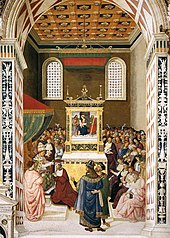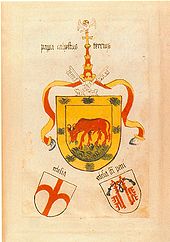Calixt III. (Pope)
Calixt III. ( Latin Callistus or Calixtus , German also Kalixt III .; * December 31, 1378 in Canals near Xàtiva , Kingdom of Valencia ; † August 6, 1458 in Rome ), original name Alonso de Borja , Italianized Alfonso Borgia , was a Spanish clergyman and dated April 8, 1455 Pope of the Catholic Church until his death . He came from the Spanish noble family of the Borgia .
Life and Church Career
He was born the son of Juan Domingo de Borja and Francina Llançol in Xàtiva, a town in València . Alonso came from the Spanish Borja dynasty, who belonged to the lower land nobility and had held various management positions in Valencia over the years. His sister was Isabella de Borja y Llançol, who was married to Jofré de Borja y Escrivà (Jofré de Borja) and was the mother of the future Pope Alexander VI. was. He first studied canon law in Lleida and began his church career in 1408. 1411 he was appointed a canon at the cathedral appointed by Lleida - a position for which the Borja family obviously state the right to propose. Around this time the Dominican penitential preacher Vicente Ferrer prophesied to the young cleric that he would one day become Pope. Alonso, who enjoyed an excellent reputation as a connoisseur of canon law, was initially by the antipope Benedict XIII. called to his court as a consultant. Benedict was one of three rival popes at the time, who were, however, removed by the Council of Constance and replaced by the newly elected Martin V in 1417 . Alonso therefore entered the service of the King of Aragón , Alfonso V. There, the main task fell on him to assert the interests of the king in negotiations with the curia. For example, Alfonso demanded numerous concessions in order to stop his support from the antipopes ( Clement VIII and Benedict XIII had refused to resign). Alfons was able to enforce his claims with the Pope through the commitment of the experienced lawyer; Clemens, to whom Alonso had personally delivered the message, then resigned.
At the intercession of the king, Alonso was made bishop of Valencia in 1429 ; As was customary at the time, the new bishop had to financially replace the king's dignity.
For Alfonso, who intended to usurp the throne of Naples (the Kingdom of Naples was a papal fiefdom) and had driven out the French Anjou , Alonso negotiated with the Pope, now Eugene IV , and reached an armistice with Rome in 1439. Alonso led the negotiations with the local nobility for the recognition of the new rule both on behalf of the king and in 1443 with the Pope, who finally recognized the rule of Alfonso over Naples; In return, the king withdrew his support for the Council of Basel - the meeting point of the internal church opposition to the Pope.
In recognition of his services, Alfons was awarded the cardinal dignity, which Alonso received in 1444 as cardinal (titular church: Santi Quattro Coronati ) of Valencia. In keeping with the customs of the time, he began to promote the careers of two nephews, the sons of his sister Isabel, Rodrigo de Borja and Pedro Luis de Borja . He brought the former to Rome in 1449.
Under the humanist Tommaso Parentucelli , elected Pope in 1447 , who took the name Nicholas V , there were far-reaching changes in Italy: the Sforza ascended the Duke's throne in Milan ( Francesco Sforza was one of the condottiere of Alfonso in Naples) and with the fall of Constantinople on May 29, 1453 the idea of the crusade gained new meaning.
After the death of Nicholas V in 1455, the conclave of the Colonna and the Orsini faced each other in the conclave , which began on April 4th of that year and in which 15 cardinals took part - fewer than ever since . But neither side was able to enforce their favorite. Cardinal Bessarion , initially introduced as a compromise candidate, failed, and that was the hour of the now 76-year-old Catalan. Old and of impeccable reputation, and an accomplished lawyer, the Cardinal of Valencia did not appear to pose a serious threat to ruling interests. On April 8, 1455, Ferrer's prophecy was fulfilled and Alonso was elected. The reason for the choice of name was ambiguous: it could be self-praise (Greek Callistos , the most beautiful, shiny) or an allusion to the Santo Cáliz , the cup of Jesus worshiped in Valencia (“ Holy Grail ”).
pontificate
His pontificate was under the sign of the struggle against the Turks , who threatened the West , and at first the old Catalan, who stood in the tradition of the Reconquista , the reconquest of the Iberian Peninsula from the Moors, was expected to give a pious pontificate without nepotism . Calixt gave up his initial reluctance in this regard in 1456. In February 1456 Rodrigo de Borja and his nephew Luis Juan de Milà were appointed cardinals. It soon became apparent that Calixt III. promoted relatives and Catalan compatriots to a great extent , which made the Spaniard in Rome, who was not very close to the people, downright hated. As early as 1457 Rodrigo was appointed Vice Chancellor of the Curia - a tenure for life that is considered the most important office after the Pope and, in any case, the most lucrative of the Curia. To this end, he was appointed captain of the papal troops, while Pedro Luis was given the command of the Castel Sant'Angelo and numerous ecclesiastical fiefs .
Calixt soon got into a conflict with his former patron, the King of Aragón, who as Alfonso I also held the throne of Naples. As the conflicts escalated, the Pope saw the Neapolitan king as the main obstacle to his greatest concern, namely the reconquest of Constantinople and a new crusade. The king threatened the pope with a council to depose him and the pope with the withdrawal of the ecclesiastical fief of Naples. When Alfons died at the height of the conflict on June 27, 1458, Calixt refused his son Ferrante (later King Ferdinand I ) the crown and withdrew the fief. His nephew Pedro Luis was enfeoffed with the vicariates of Terracina and Benevento , which the deceased king had previously held, and he was entrusted with leading the troops in the war against the Aragonese - the Kingdom of Naples, according to Calixt's intention, was to fall to his family . Rodrigo, as Alexander VI. later Pope himself, should take up this idea again for his son Cesare Borgia .
When Calixt became seriously ill at the end of July, the power structure of the Borgia collapsed: Pedro Luis had to hand over the Castel Sant'Angelo while the Orsini recaptured their lost castles. On August 6, 1458, Calixtus died in Rome.
During his pontificate, Calixt initiated a revision of the trial of Joan of Arc , in the course of which she was rehabilitated, and canonized the Dominican Vicente Ferrer , who had once foretold him the papal crown.
On June 29, 1456, Calixt ordered in a papal bull that one or more church bells should ring at noon to call the faithful to pray for a victory of the Hungarians under their leader Johann Hunyadi over the Ottomans (popularly known as "Turks" ). This introduced the noon ringing , which continues to this day.
Calixt III. stood far from the humanist movement at the curia and had little interest in the arts and sciences.
He was buried in the chapel of Santa Maria della febbre next to St. Peter's Church at the Vatican. After the rebuilding of St. Peter in the 16th and 17th centuries, the bones were transferred to the Roman church of Santa Maria di Montserrato .
rating
Calixt III. was not only an excellent lawyer, but also committed to religious concerns, as his commitment to Constantinople shows. He led a simple life, was averse to any ostentatiousness, held a simple blackboard and had no affairs - and no children either, which set him apart from the multitude of religious dignitaries of the time. All of this was decisive for his choice, and he was already old. Also, as a cardinal, he had not promoted his relatives more than usual, but that changed during his pontificate.
The elected popes were allowed to make at least one relative cardinal, and the enfeoffment of relatives with ecclesiastical fiefs and the granting of lucrative benefices was quite common and accepted. Since he had shown no signs of the then common greed for power and money until his election as Pope, it was said that Alonso would maintain his restraint as Pope.
In fact, Calixt continued to abstain from all affairs or a lavish lifestyle, but not nepotism . His predecessors - such as Boniface VIII , who had given his numerous relatives a large number of fiefs - paid homage to this principle, but none did it as aggressively as Calixt. Passing smaller hereditary goods on to relatives was a common custom. For the first time, however, under Calixt, the efforts of the papacy were aimed at providing a papal nepot with a territory that extended beyond a county (in this case the kingdom of Naples). With the year 1458 began a phase of nepotism that can be described as territorial nepotism. For all the popes who followed him, the walls of decency and self-restraint were torn down. In the future they did not shy away from murder or war for the goods of their nephews .
See also
literature
- James MacCaffrey: Pope Callistus III . In: Catholic Encyclopedia , Volume 3, Robert Appleton Company, New York 1908.
- Friedrich Wilhelm Bautz : Calixt III. In: Biographisch-Bibliographisches Kirchenlexikon (BBKL). Volume 1, Bautz, Hamm 1975. 2nd, unchanged edition Hamm 1990, ISBN 3-88309-013-1 , Sp. 860-861.
- Michael E. Mallett: Callisto III. In: Massimo Bray (ed.): Enciclopedia dei Papi. Volume 2: Niccolò I, santo, Sisto IV. Istituto della Enciclopedia Italiana, Rome 2000, pp. 658-662 ( treccani.it ) ..
- Volker Reinhardt : Pontifex. The history of the Popes from Peter to Francis . 2nd, revised edition. CH Beck, Munich 2018, ISBN 978-3-406-70381-2 , ISBN 978-3-406-703812-2 ( defective ) , p. 463-466 .
Web links
- Entry to Calixt III. on catholic-hierarchy.org
- Literature by and about Calixt III. in the catalog of the German National Library
Individual evidence
- ↑ a b Volker Reinhardt: Pontifex. P. 464
- ↑ a b Volker Reinhardt: Pontifex. P. 463
- ↑ a b c Borja, Alfonso de. In: Salvador Miranda : The Cardinals of the Holy Roman Church. ( Florida International University website , English)
- ↑ a b c Volker Reinhardt: Pontifex. P. 465
| predecessor | Office | successor |
|---|---|---|
| Nicholas V. |
Pope 1455-1458 |
Pius ii |
| Hugo de Lupia y Bages |
Bishop of Valencia 1429–1452 |
Rodrigo de Borja |
| personal data | |
|---|---|
| SURNAME | Calixt III. |
| ALTERNATIVE NAMES | Callistus; Calixtus III .; Kalixt III .; Borja, Alonso de; Borgia, Alfonso |
| BRIEF DESCRIPTION | Spanish clergyman, Pope (1455–1458) |
| DATE OF BIRTH | December 31, 1378 |
| PLACE OF BIRTH | Canals at Xàtiva , Valencia |
| DATE OF DEATH | August 6, 1458 |
| Place of death | Rome |


